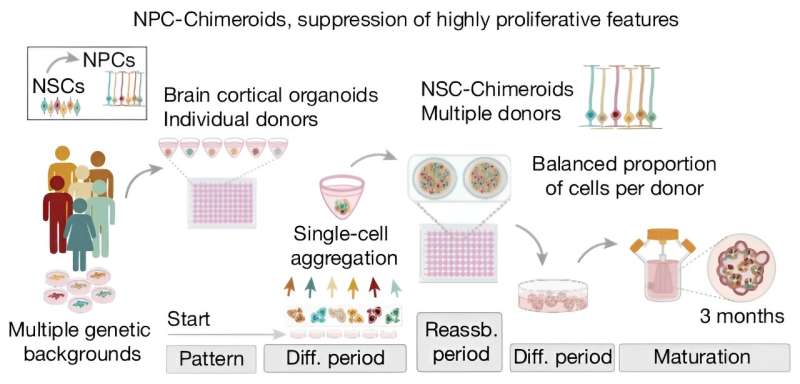June 27, 2024 report
This article has been reviewed according to Science X's editorial process and policies. Editors have highlighted the following attributes while ensuring the content's credibility:
fact-checked
peer-reviewed publication
trusted source
proofread
Creating chimeroids by mixing stem cells from different donors to create multiple cell line organoids

A team of stem cell and regenerative biologists at Harvard University, working with a trio of colleagues from the Broad Institute of MIT and Harvard, has created what they call chimeroids—function organoids with multiple cell lines.
Their paper is published in the journal Nature. Aparna Bhaduri with the University of California, Los Angeles, has published a News & Views piece in the same journal issue explains why their findings could lead to new avenues of brain research.
Prior research has shown that the human brain is too complex to use other species, such as chimpanzees, as models for research. Scientists have been looking for other ways to tackle the problem. One partial solution is organoids—organ-like structures grown using pluripotent stem cells.
In prior efforts, research teams have grown functioning, brain-like organs in their labs using this approach and have used the organelles to learn more about how the brain develops, what happens when things go wrong, and how therapies might address ailments.
But one glaring weakness in this approach has been the inability to use them to study how genetics impacts brain development or how the brain responds to therapies. In this new effort, the research team has found a possible way around this problem.
Reasoning that growing a single brain organoid, or a part of one, such as the cortex, with cell lines from different people would result in the creation of an organoid with different genes, a type of chimeric organoid, the team set out to find a way to achieve it.
After much experimenting, the researchers achieved the desired results by obtaining pluripotent stem cells from multiple individuals—in this case five people. They used the cells to start the organoid growing process, differentiating them to grow into the type of neural progenitor cells they desired.
Next, they broke each of pre-organoid tissue samples into multiple parts and then mixed them all together, allowing the results to grow into a multi-cell-line organoid, which they call a chimeroid. DNA and RNA testing showed the chimeroid had grown into a multi-cell-line organoid.
The research team then exposed several of their chimeroids to ethyl alcohol to see how it impacted the neural growth of cells from different people and found differences, showing that consuming alcohol can impact the brains of people differently depending on their genetic makeup.
The team suspects a host of new studies will be undertaken by many other groups using their approach to compare the way the brain responds under different scenarios in which only genetics differ.
More information: Noelia Antón-Bolaños et al, Brain Chimeroids reveal individual susceptibility to neurotoxic triggers, Nature (2024). DOI: 10.1038/s41586-024-07578-8
Aparna Bhaduri, Chimeric brain organoids capture human genetic diversity, Nature (2024). DOI: 10.1038/d41586-024-01648-7
© 2024 Science X Network




















